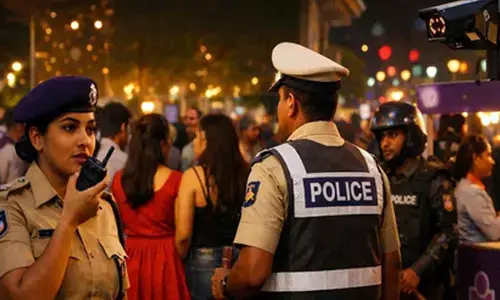Another nurse dies of dengue

Another Nurse Dies of Dengue, Dengue And Malaria Cases, Osmania General Hospital. Even official figure relating to dengue and malaria cases in the city and elsewhere are quite scary. It appears that the two deadly diseases would prove to be major public health concerns in the days ahead.
Alarming cases of dengue, malaria cases in city.
Even official figure relating to dengue and malaria cases in the city and elsewhere are quite scary. It appears that the two deadly diseases would prove to be major public health concerns in the days ahead. The death of the 20-year-old student of Osmania Nursing College in a city hospital on Friday, after battling dengue for seven days, could be the tip of the iceberg. Mosquitoes become immune to conventional fogging and others methods of control over years, and there lies the curse. The health department personnel appear to be a confused lot.
The girl’s case was actually the second dengue-related death in the last 12 days in the city. For, on October 6, another nursing student of the same college died due to dengue.
Call it carelessness of the college or crass negligence of the public health authorities, one thing is clear: insanitary conditions in the hospital contributed to the deaths.
Observers say if this is the case with hospitals one can imagine the fate of ordinary homes located in city areas that are neglected by the sanitation wing of the civic authorities.
L Vandan Kumar, Additional Commissioner (Health & Sanitation), said that the living conditions and the level of sanitation maintained were not up to the mark in the nursing hostel of Osmania General Hospital.
In the wake of the two deaths attributed to dengue, the Additional Commissioner, along with N Ravi Kiran, Zonal Commissioner, South Zone, V Venkatesh, Chief Entomologist, and staff members inspected the premises of the nursing hospital on Saturday. After inspection, while addressing the media, he said that OGH people had outsourced sanitation maintenance and that upon receiving information on the first death 15 days ago, the GHMC had sent its teams for clearing garbage and taking up sanitation measures there.
The Additional Commissioner (H&S) mentioned that they had information that the building would be demolished to enable construction of a new structure. The GHMC would issue a notice to the Superintendent/RM of OGH, seeking information regarding sanitation and other conditions prevailing at the nursing hostel. The GHMC had not received confirmation of dengue prevalence from IPM (Institute of Preventive Medicine).
However, Dr Narendrudu, DMHO, said that since October 15, around 12 cases of suspected dengue fever had been reported in the city, of which 11 were detected positive. He said that he had not received any report of dengue-related death.
He continued, “Only after confirming that the death was due to dengue, I will comment. Apparently there are four different types of tests that can be conducted. The most reliable affirmation will be by conducting the Enzyme-Linked Immunosorbent Assay (ELISA) test which we are about to conduct. We will receive the reports by Monday.”
Although the Hemagglutination-Inhibition (HI) test has been the standard one used by the World Health Organization (WHO) for the classification of serologic response in dengue infections, ELISA test is preferred in order to reduce any type of absurdity. The HI test is slow as it requires paired specimens.
By mid-October this year the toll due to dengue reached 62, while malarial deaths leaped to nearly 162 in Hyderabad alone. Although doctors are concerned over the rising number of dengue and malaria cases, the civic authorities continue to play them down as if the two diseases are of little or no consequence.
In July this year, a joint coordination meeting was held, involving assistant medical and health officers, the chief entomologist and assistant entomologists, with focus on dengue and malaria. The meeting resulted merely in making sound appeals, requests and directions. Action has been practically nil.
The GHMC authorities mouthed platitudes that the corporation was equipped to handle any eventuality. But what it has done and what is on record shows that things are taking an alarming turn. With outsourced help, the civic body claims to have engaged the services of 2,200-strong personnel equipped with 134 fogging machines, 11 vehicles, 500 sprayers and nearly 100 pumps.
During the joint coordination meeting Hyderabad district joint collector G Rekha Rani had directed all medical officers to be vigilant in identifying the hot spots. The officials were asked to focus on slum areas. The additional commissioner, H&S, GHMC, L Vandan Kumar, was requested to provide a list of slums to all the officials concerned so as to enable them to conduct medical camps in slums with a view to creating awareness about the ill effects of the communicable diseases.
The H&S chief of the civic body directed the chief entomologist to display flex banners at the venues of all medical camps for easy identification and to create awareness about joint operations of the government departments.
Currently there are 36 areas in the city that have been identified as high-risk areas for dengue and malaria. Over 600 cases of vector-borne diseases have been detected in GHMC limits and as for malaria 528 cases have been registered since 2012.
As per the directions, the civic body then started a special drive to check the vector-borne diseases in every circle under GHMC limits. The activities in the special drive included health camps and disease surveillance under close expert monitoring. The focus was to be on anti-larval operations.
The authorities are now agreed that since mosquitoes had become immune to fogging operations, there is emergent need for stronger and efficacious anti-larval operations.
Understanding the state of the affairs, anti-larval operations have been intensified. According to Rakesh Kumar, Entomology Field Assistant, Kapra Circle, “We understood that fogging machines and DDT have become less usable. The machines are not helping in serving its true purpose but were causing allergies to asthma patients. We went on to spread awareness in every household. To kill the larva we then started using Temephos and Baytex sprayer and we believe we have considerably reduced the number of mosquitoes in areas of Kapra circle. We have nearly eight teams who near 200 households.”
Every entomologist in the GHMC circle is now informed about the ineffectiveness of using smoke machines.
Mahesh Kumar, AE of Charminar circle, where the girl died, could not confirm that proper anti-larval operations had been taken up in those areas. “We used fogging machines, but people resisted and some members of the Nursing College were not cooperative. Then I believe they asked the pest control department to conduct anti-larval operations. I don’t know what happened after that.”
Woman injured in stabbing attack in Tokyo, suspect at large
Bengal cop booked for murder over mysterious death of woman home guard, SIT to probe case
Staffer recalls horror of 7-kg gold robbery by armed gang in Karnataka’s Hunsur
25-Year-Old Airline Cabin Crew Member Dies At Gurugram Party; Police Begin Investigation

















